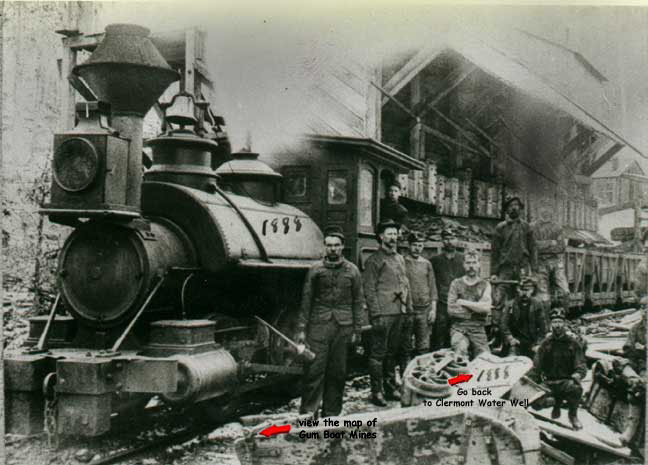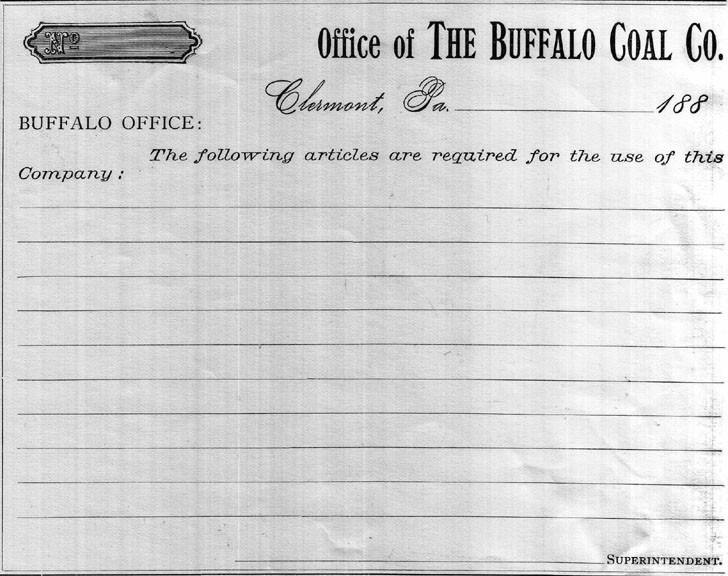south of Clermont, Pennsylvania

photo credit: Clermont Reunion 2000

Without the coal mines, there probably would not have been a Clermont. While lumbering and clay products created jobs and revenue, coal was King. And, of the many mines in the Clermont area, none were more productive than the Gum Boot Mines of the Buffalo Coal Company.In the Spring and Summer of 1874 Professor John MacFarlane, a mining engineer and geologist, explored and tested the coal outcropping in the Clermont area, at the expense of General George J Magee. The Buffalo Coal Company was formed with Magee President. Other stockholders included GR Wilson, J Condit Smith, SS Jewett, FH Root, NG Fargo, WH Glenney, PP Pratt, EP Beals, FL Danforth, GB Gates, WT Wilson, NC Rumsey, SF Hamlin, C Clark, GT Williams and JL Schoelkoepf, all of Buffalo, New York; Byron D Hamlin of Smethport, Gen. George Magee of Watkins, NY; James Macfarlane of Towanda, Pa; JF McPherson of Warren; Graham Macfarlane of Pa; D Howell of Bath, NY and Daniel Beach and J Lang of Watkins, NY. With a capital of one million dollars and a railroad company called the McKean and Buffalo Railroad(the latter with $400,000 capital, and Byron Hamlin President and Delano Hamlin a director). The railroad company began operations in October 1874, and was ready to carry freight by the next Spring. With the railroad came changes; Except for Instanter in 1809 and Teutonia in 1843, the area was generally known as Bunker Hill (although the Bunker Hill Farm was a couple miles east-northeast of the mines). Jacob Ridgway?s Claremont Farm gave rise to the name Clermontville, which eventually was shortened to Clermont. The first Buffalo Coal Company mine was located near the WNY and P Railroad station, and opened in 1874. This was the largest and most profitable mine worked in McKean County . Within a short time it was averaging 500 tons daily, and large trains leaving for the Buffalo docks were common. Five years later the Gumboot mines were opened, about two miles west-southwest of the first mine. A narrow gauge railroad was built and the coal was hauled to the WNY and P tracks. The miners who lived in the company housingcalled The Patch rode the train to work as it cut across the original site of Instanter, then passed just north of Teutonia and continued to Gum Boot Run.
By 1883 competition and cheap coal produced a slump, and in July 1885 the mines closed. They were to reopen on a smaller scale under Milo Lyman of Roulette. Many of the miners went to Indiana and Jefferson Counties.
A look at the McKean County Miner gives a glimpse of coal in Clermont: July 13, 1894 On May 16 the 50 miners employed in the mines at Clermont laid down their tools and struck in sympathy with the miners who were on strike throughout the union. These men at the time were receiving 65 cents a ton for mining, this being the rate agreed upon in the Spring as satisfactory for themselves and the company. July 11 the men commenced work again at the reduced price of 60 cents a ton. They have been idle 49 days, at a loss to themselves in wages, allowing the average day?s work under the old scale to have been $1.80 of $4,410.
November 1,1995 Messrs. Butts and Keating have no trouble in hiring all the miners they want these days, as they are coming from the districts where the men are on strike.
January 17,1896 The Western New York and Pennsylvania Railroad has the new switch to the Lyman?s Coal Mine nearly completed.
February 7, 1896 Lumber is on the ground for the new blacksmith shop at the mouth of the Lyman?s mines.
February 14,1896 The miners of the Buffalo Coal Company have been laid off for a few days owing to the railroad being blockaded with snow.
August 20, 1897 The miners at Clermont are working steady and a great deal of coal is getting out daily.
November 5, 1897 The large safe of the Buffalo Coal Company at Clermont was blown open by burglars last Friday night. It was a double door safe and a hole one-half inch in diameter had been drilled just in front of the lock. The burglars carried the cash box down to "the Patch" and took the spoils, $1.50 in nickels and pennies. A filing case for papers was taken and papers satterred.
A similar attempt was made 12 years ago but this was frustrated by the close proximity of a dance. The tools were stolen from the blacksmith shop of H
Palmer and Son, and consisted of a 20-pound sledge, three chisels, a punch and a large monkey wrench.The mines were recently in the news as a partnership of Elk County Sportsmen?s Clubs and state agencies joined forces to build a limestone dam to filter the acid runoff from the mines, which make their way into Gumboot Run and the East Branch Dam.

